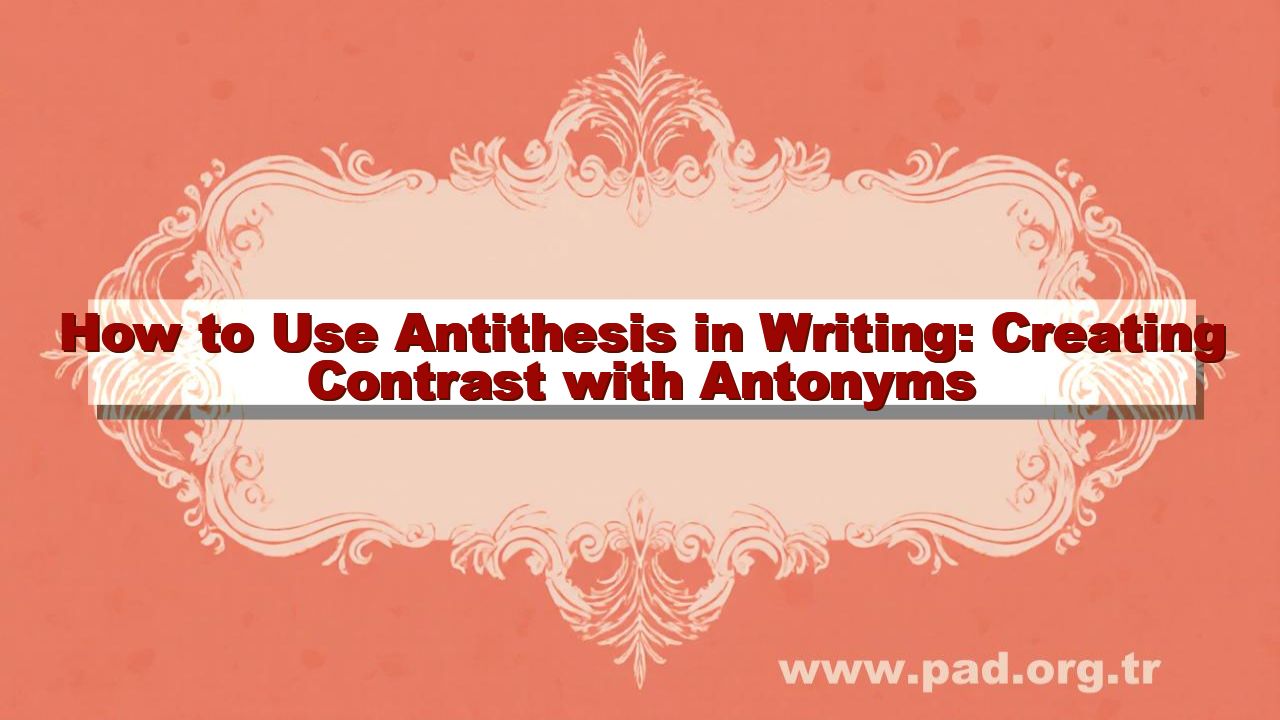I distinctly recall giving a presentation in college, rambling on about a complicated philosophical concept. The audience looked bored out of their minds. After class, the professor pulled me aside and said, “Look, you need to use rhetorical contrast.” He pointed to a quote by John F. Kennedy: “Ask not what your country can do for you—ask what you can do for your country.” The moment I saw that perfectly balanced opposition between ‘country doing for you’ and ‘you doing for country,’ I realized antithesis isn’t just decoration; it’s a powerful tool for clarity and conviction. İf your goal is to write things that stick with people long after they’ve read them, learning to wield antithesis is non-negotiable.
What Makes Antithesis Pop? The Rule of Balance
Antithesis is more than just throwing an antonym into a sentence. The true effectiveness of this technique lies in its parallel or balanced structure. You aren’t just saying ‘good, then bad’; you are setting up two grammatically similar halves that mirror each other, making the contrast between the opposite words (the antonyms) incredibly sharp. This is what creates that satisfying snap when the reader processes the sentence.
The Structure of Stunning Contrast
To use antithesis successfully, you need to structure your phrase like a perfectly weighted scale. The grammar on one side must match the grammar on the other side. This parallelism forces the reader to acknowledge the contrast immediately.
- Noun Phrase vs. Noun Phrase: “Patience is bitter, but its fruit is sweet.” (Adjective/Noun structure is mirrored).
- Verb Phrase vs. Verb Phrase: “To err is human; to forgive, divine.” (Infinitive phrase structure is mirrored).
- Clause vs. Clause: “Money is the root of all evil; lack of money is the root of all good.” (The structure ‘X is the root of all Y’ is repeated).
Due to the fact that the human brain naturally seeks patterns and balance, presenting opposite ideas in an identical structural framework makes the contradiction immediately obvious and intensely memorable. This is the difference between writing that is merely informative and writing that is genuinely impactful.
Antithesis in Action: Examples That Stick
Want to see the power of using antithesis in writing? Look at these famous examples. They show how simple antonyms—when placed in parallel structures—can convey deep, complex ideas efficiently. These aren’t complicated words; they are simple words used in a strategically opposed way.
- Simple Adjective Contrast: “It was the best of times, it was the worst of times.” (Dickens uses the absolute contrast of ‘best’ and ‘worst’ to describe a period).
- Opposite Concepts/Actions: “Give every man thy ear, but few thy voice.” (Shakespeare opposes the actions of listening and speaking).
- Personal vs. Societal: “That’s one small step for a man, one giant leap for mankind.” (The contrast between the single, small personal action and the massive, universal result).
Here is a truly complicated sentence that demonstrates the power of balanced antithesis: While most people spend their entire lives chasing fleeting external validation through the accumulation of superficial wealth, the truly wise individual understands that lasting tranquility is only achieved through arduous internal self-mastery, a pursuit which requires a deliberate rejection of transient applause in favor of permanent self-respect.
Advanced Techniques: Antithesis in 2025
In the digital landscape of 2025, clear, punchy communication is everything. Antithesis is being used to distill complex arguments down into shareable, high-impact statements, particularly in social commentary and brand messaging. The trend is moving toward contrasting new technological concepts with older humanistic ones. The Complete Guide to Antonyms has to reflect these modern verbal clashes.
- Digital vs. Real: The struggle is no longer between ‘work’ and ‘rest,’ but between Digital Engagement and Authentic Presence.
- AI vs. Human: The new debate is about prioritizing Algorithmic Efficiency over Creative Imperfection.
- Data vs. Intuition: Madem ki Big Data guides all decisions, antithesis is used to argue for the counterpoint: Due to the fact that models often fail to capture nuance, successful leaders must balance Empirical Evidence with Deep-seated Intuition.
This weekly update for October 25, 2025, shows that antithesis is actively being used to frame the core philosophical struggles of our time—it’s always about finding the perfect antonymic pair to define the two sides of a difficult choice. Due to the fact that information overload is a constant reality, concise antithesis is prized higher than ever, serving as a linguistic shortcut to profound meaning.
FAQ Schema: Using Contrast to Write Better
What is the difference between antithesis and oxymoron?
This is a great question. An oxymoron is the juxtaposition of two contradictory words side-by-side, usually forming a single descriptive phrase (e.g., ‘jumbo shrimp,’ ‘deafening silence’). Antithesis, on the other hand, is much broader. It places two contrasting ideas or clauses in a balanced, parallel sentence structure to express a larger concept or argument, often using multiple antonyms across the sentence.
How can I practice using antithesis in my daily writing?
The simplest way to practice is to start with a famous quote and replace the key nouns and verbs with your own. Take “A moment of pain is worth a lifetime of glory.” Try changing it to: “A moment of fear is worth a lifetime of regret.” By focusing on the structural balance first, you force yourself to find the right antonyms to fill the contrasting roles, making the technique feel more natural.
Does antithesis only work with absolute antonyms (like Complementary Antonyms)?
No, it works beautifully with all types! While absolute opposites like ‘dead’ and ‘alive’ give a clear-cut punch, gradable antonyms (like ‘cold’ and ‘warm’) or relational antonyms (like ‘giving’ and ‘receiving’) create more subtle, nuanced contrasts. Using words that are on opposite ends of a spectrum—even if a middle exists—still creates the necessary tension for powerful antithesis.

